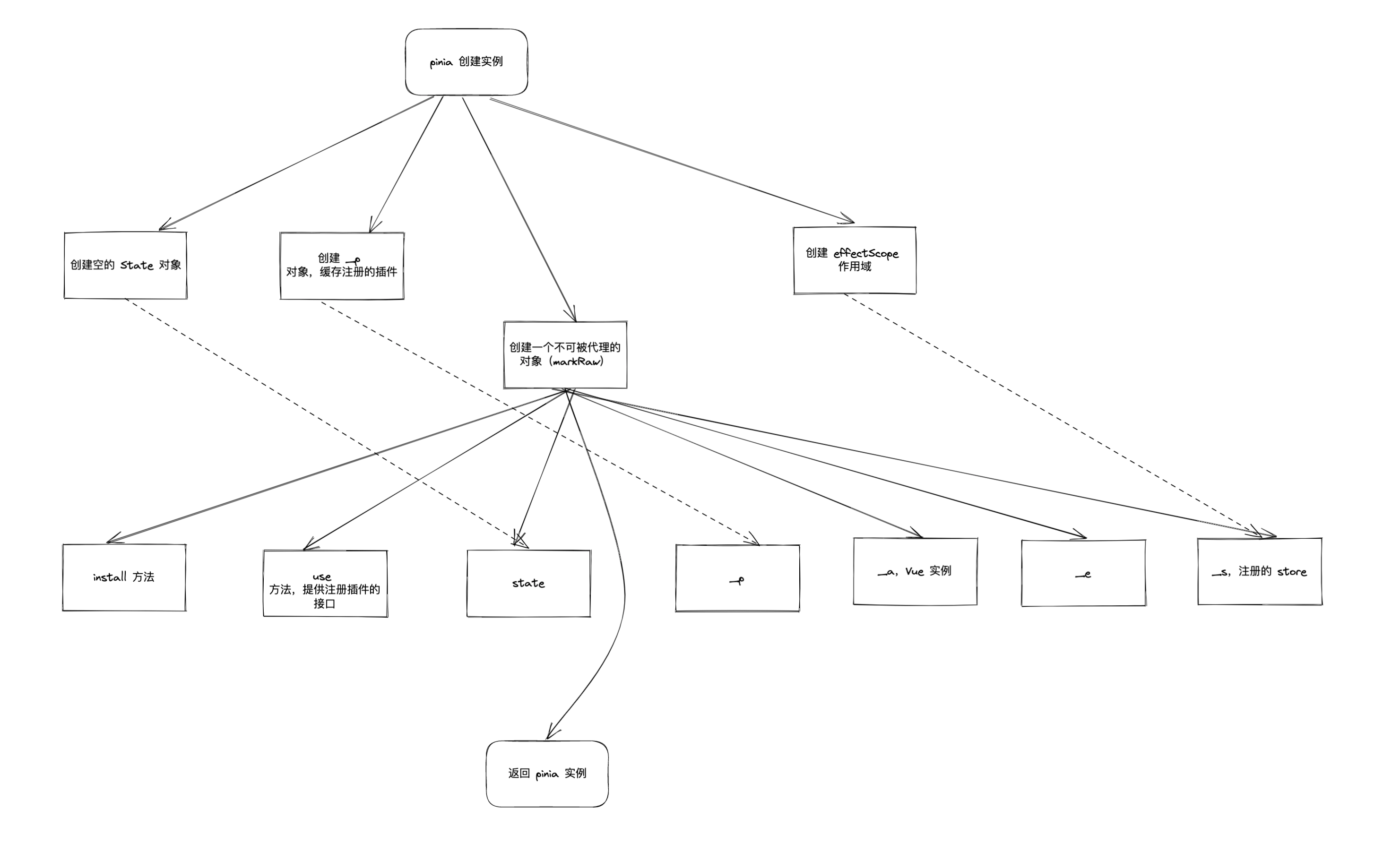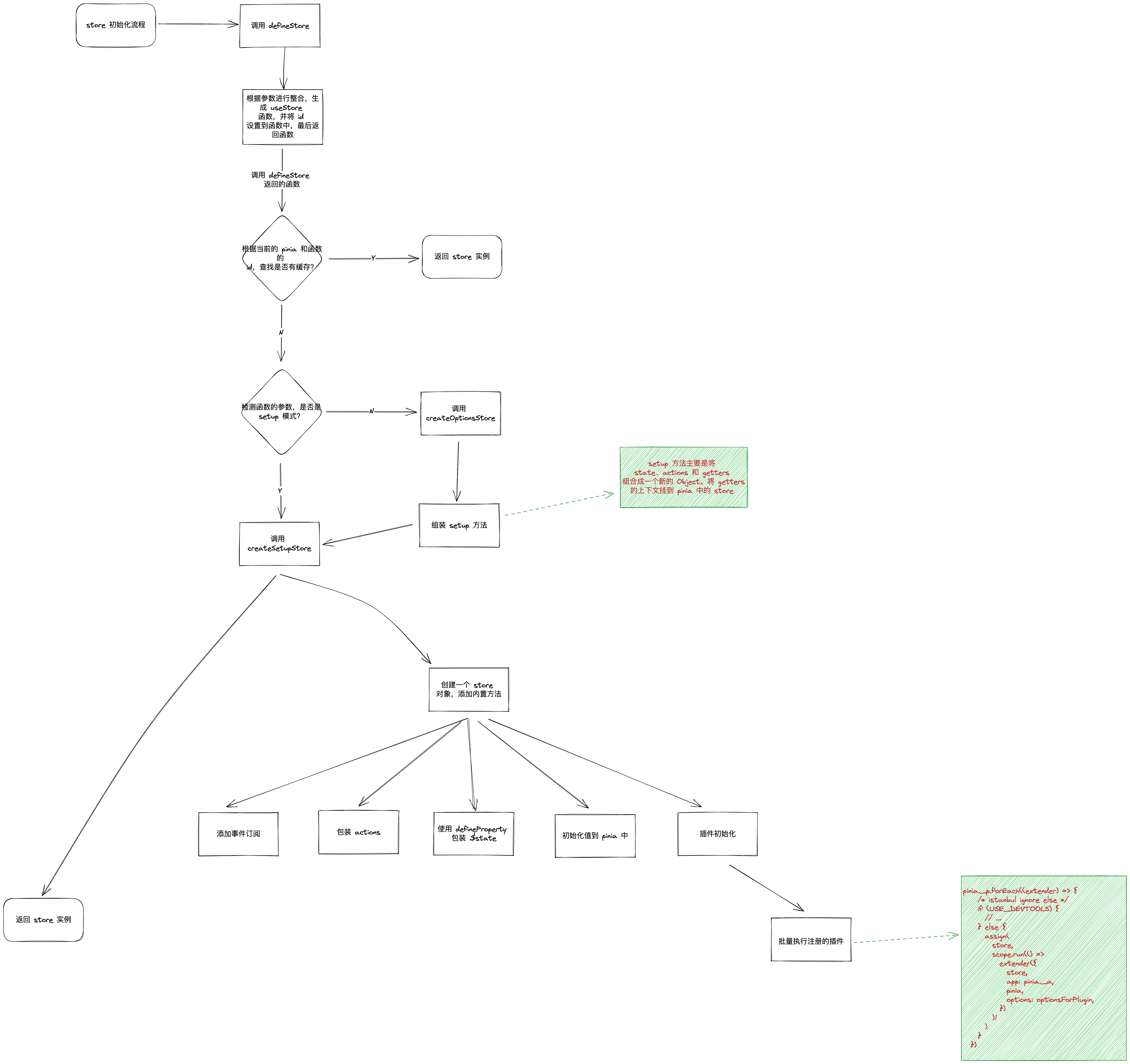学习的目标
- Pinia 的整体架构是怎样
- 学习原理,如何缓存数据
Pinia 的整体架构


问题
vue3 中的 markRaw 的作用
将一个响应式对象/对象转为普通对象,并且标记不可被转为代理
vue3 中的 effectScope 的作用
生成一个临时的作用域空间,在这作用域空间下使用的 ref, watch, watchEffect 等工具,当着作用域要销毁时,里面的响应式都会随之而销毁
简单来说,就是帮你创建一个临时的作用域,让你不需要处理里面的响应式的销毁时刻,响应式会随作用域自动销毁
代码演示:
typescript
const scope = effectScope();
const state = scope.run(() => {
const b = ref(2);
watch(b, () => {
console.log("update b", b.value);
});
return { a: 1, b };
});
state.b.value += 1; // 触发日志 update b
setTimeout(() => {
scope.stop();
state.b.value = 0; // 不会触发日志
}, 100);为什么 Pinia 要使用 effectScope?
统一收集各个 store 的响应式,可以在同一个时刻下对各个 store 进行销毁处理
Pinia 是如何实现不需要额外定义 TypeScript 类型
vuex 的 TypeScript 定义
vuex@4 还是需要额外的定义 state 的类型:
typescript
// store.ts
import { InjectionKey } from 'vue'
import { createStore, Store } from 'vuex'
// define your typings for the store state
export interface State {
count: number
}
// define injection key
export const key: InjectionKey<Store<State>> = Symbol()
export const store = createStore<State>({
state: {
count: 0
}
})typescript
// main.ts
import { createApp } from 'vue'
import { store, key } from './store'
const app = createApp({ ... })
// pass the injection key
app.use(store, key)
app.mount('#app')typescript
// in a vue component
import { useStore } from 'vuex'
import { key } from './store'
export default {
setup () {
const store = useStore(key)
store.state.count // typed as number
}
}Pinia 的处理方式
Pinia 通过泛型的形式,根据用户传入的值自动生成对应的类型描述:
typescript
// 伪代码
export function defineStore<
Id extends string,
S extends StateTree = {},
G extends _GettersTree<S> = {},
// cannot extends ActionsTree because we loose the typings
A /* extends ActionsTree */ = {}
>(
id: Id,
options: Omit<DefineStoreOptions<Id, S, G, A>, 'id'>
): StoreDefinition<Id, S, G, A>定义了 ID, S(state), G(getters), A(actions) 等四个泛型,分别对应使用 defineStore 传入的各个值,这样就能自动生成 TypeScript 的描述。
Pinia 的 TypeScript 定义那么简单,为什么 Vuex@4 不能实现?
TODO...
插件机制的实现原理
注册插件:
在 createPinia.ts 的 createPinia 中:
typescript
// 伪代码
use(plugin) {
_p.push(plugin)
return this
}只是简单的将用户传入的插件函数,存在 _p 中
在 store.ts 中的 createSetupStore 函数,有这样一段代码:
typescript
// 伪代码
// apply all plugins
pinia._p.forEach((extender) => {
/* istanbul ignore else */
if (USE_DEVTOOLS) {
// ...
} else {
Object.assign(
store,
scope.run(() =>
extender({
store,
app: pinia._a,
pinia,
options: optionsForPlugin,
})
)!
)
}
})它将当前 defineStore 生成的 store ,Pinia 的实例,Vue 实例和插件的配置传入给插件(函数)中,插件会执行相关的业务代码,从而形成插件。
插件可以做到事:
- Add new properties to stores
- Add new options when defining stores
- Add new methods to stores
- Wrap existing methods
- Change or even cancel actions
- Implement side effects like Local Storage
- Apply only to specific stores
常见能做的事情:
批量插入属性
数据持久化
- 插件可以监听任何数据的变化
action 的封装,比如在执行任何 action 前,可以进行一些拦截操作
实现一个简单的 store
javascript
const useStore = defineStore({
state: () => ({ d: 1 }),
getters() {
return {
a: (state) => {},
b() => this.xxx
}
},
actions: {
getA() {
return this.a
},
setD(val) {
this.d = val
}
}
})
// use
const user1 = useStore()
const user2 = useStore()
user1.d === user2.d
user1.d = 2
user1.d === user2.d
user2.setD(3)
user1.d === user2.d
user1.d // 3
user2.d // 3实现代码:
typescript
import { reactive, UnwrapNestedRefs, watchSyncEffect } from "vue";
type DefaultState = Record<string, any>;
type DefaultAction = Record<string, (this: any, ...args: unknown[]) => unknown>;
type StoreGetters<T extends DefaultState> = Record<
string,
(state?: T) => unknown
>;
type StoreIns<
S extends DefaultState = {},
G extends StoreGetters<S> = {},
A extends DefaultAction = {}
> = UnwrapNestedRefs<S> & G & A;
interface MockPinia<
S extends DefaultState,
G extends StoreGetters<S>,
A extends DefaultAction
> {
stores: Record<string, StoreIns<S, G, A>>;
get: (id: string) => StoreIns<S, G, A> | undefined;
set: (id: string, store: StoreIns<S, G, A>) => StoreIns<S, G, A>;
}
const stores: Record<string, StoreIns> = {};
const mockPinia: MockPinia<
DefaultState,
StoreGetters<DefaultState>,
DefaultAction
> = {
stores,
get: (id) => stores[id],
set: (id, store) => (stores[id] = store),
};
// 将用户传入的配置,形成响应式的
function handleData<
S extends DefaultState,
G extends StoreGetters<S>,
A extends DefaultAction
>(
store: StoreIns<S, G, A>,
options: {
state: () => S;
getters: G;
actions: A;
}
) {
// 处理 state
const initState = options.state();
Object.entries(initState).forEach(([k, v]) => {
// @ts-ignore
store[k] = v;
});
// 处理 actions
Object.entries(options.actions).forEach(([k, v]) => {
// @ts-ignore
store[k] = v.bind(store);
});
// 处理 getters
Object.entries(options.getters).forEach(([k, v]) => {
watchSyncEffect(() => {
// @ts-ignore
store[k] = v.call(store, store);
});
});
}
export const defineStore = <
$id extends string,
S extends DefaultState,
G extends StoreGetters<S>,
A extends DefaultAction
>(
id: $id,
options: {
state: () => S;
getters: G;
actions: A;
}
) => {
const store: StoreIns<S, G, A> = reactive({}) as StoreIns<S, G, A>;
handleData(store, options);
function use() {
return store;
}
use.$id = id;
mockPinia.set(id, store);
return use;
};